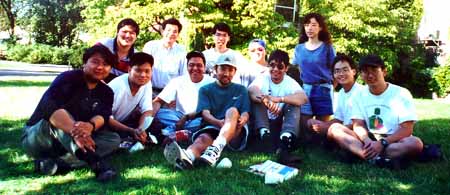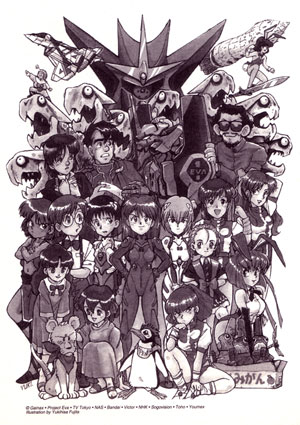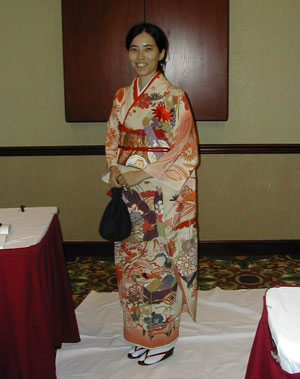(adapted from a review I posted on Anime Grapevine on 1/27/04)
Introduction
Star Trek fans have
Trekkies and Star Wars fans have
The Phandom Menace, and now anime fans have
Otaku Unite!. There have been a few anime fan documentaries that predate
Otaku Unite!, but those have tended to be limited in scope and/or production value.
Otaku Unite! is probably the most ambitious American anime fan documentary project to date, and I happen to like it a lot.
Please note: I am not exactly a neutral reviewer. Before the film was finished, I happened upon its
official website, and I submitted some of my otaku-related essays for publication on that site. I was excited by the project, and it looked like the makers were taking it seriously, so I offered to help out in any way I could. During the making of the film, Eric Bresler (the director) contacted me, and I did some research for him and provided some historical materials (from the early days of fandom) for inclusion in the film.
That said, I was only indirectly involved with the making of
Otaku Unite! When it debuted at Anime Weekend Atlanta 9, it was my first time seeing it. I thought it was excellent, and the audience appeared to get a big kick out of it as well. I was proud to have my name appear (ever so briefly) in the credits.
Summary
So what's it about? Here's what the official website has to say about it:
Otaku Unite! is an independent, feature-length documentary on the history of Japanese animation fandom in the United States. The title refers to the anime fans ("otaku") whose combined efforts have enabled fandom to thrive for over 25 years. This sense of unity is apparent at any given anime convention, at any of the multitude of anime fan clubs and organizations, at any online forum. Otaku Unite! illustrates this sense of unity by covering the evolution of fandom from its former state of scattered pockets of avid fans to the current high in both the visibility and popularity of anime in the United States. Whether you're a die-hard anime fan, a casual cartoon-viewer, or an unknowing movie-goer, Otaku Unite! will be sure to both entertain and inform.
I think that's a pretty decent summary, but let me paint a more detailed picture of what the movie is like.
Content
Otaku Unite! relies heavily on interview footage. The makers of OU! traveled all over the place, including 9 conventions, to interview con-going anime fans, celebrity fans, artists, anime experts, and members of the American anime industry. There is no director's voiceover; Eric allowed the otaku community to speak for itself. I was pleased to see anime fans being portrayed respectfully--all the interviewees were intelligent, articulate, and interesting people--and with a sense of humor, making it clear that anime fans are fun and irreverent people who do not take things over-seriously.
OU! addresses several issues, including (but not limited to):
- What do different people think of the term "otaku"?
- What makes anime interesting to fans?
- What do fans get out of conventions?
- What is the appeal of cosplay?
- How did anime fandom evolve in the United States?
A large part of the documentary focuses on the early history of fandom in the United States and how it has changed into what we know today.
OU! contains quite a bit of anime footage. Some of it (from
Otaku no Video, for example) is used to humorously illustrate some facet or other of anime fandom. Most of the anime footage, however, is used to highlight the classic anime that old school anime fans used to watch.
OU! also features a lot of convention footage. Fans of cosplay will not be disappointed. Even yaoi fans will have something to cheer about, since Yaoi-Con was one of the nine conventions that OU! visited. One very interesting piece of con footage featured the marriage of Robert DeJesus (American manga artist) to Emily Brown at Anime Central 2001, which was most likely the first (and only?) wedding officially held at an anime convention.
Conclusion
Overall, I feel that
Otaku Unite! did a good job looking at the (more-or-less) current state of anime fandom, especially in relation to fandom's earlier days. It is both an historical document and an exploration of a contemporary social phenomenon that is really quite fascinating.
The scope of anime fan activities is far too large to be fully covered in a single feature-length documentary. For example,
Otaku Unite! did not discuss
online anime fandom in much detail. The film definitely could have covered a lot more material, but what it did cover, it covered well. As such, I highly recommend
Otaku Unite! to both fans and non-fans of anime. Open-minded non-fans will find this portrayal of anime fandom intriguing and entertaining, and fans will feel proud as they see their own culture being faithfully represented on screen.
Otaku Unite! is now widely available on DVD.




 I was also supposed to be on the Anime Roundtable (discussing various issues relevant to anime fans), but that was cancelled (maybe next year). Also on Saturday, Lillian and I had a nice dinner with fellow guest
I was also supposed to be on the Anime Roundtable (discussing various issues relevant to anime fans), but that was cancelled (maybe next year). Also on Saturday, Lillian and I had a nice dinner with fellow guest